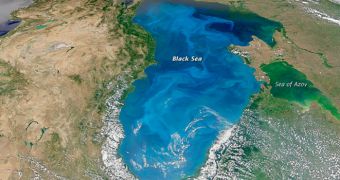An image captured on July 15 by the Moderate Resolution Imaging Spectroradiometer (MODIS) instrument, on the NASA Aqua satellite, shows a massive phytoplankton bloom (in brilliant cyan colors) on the surface of the Black Sea.
Most of the microorganisms in this bloom are most likely Coccolithophores, a species of phytoplankton renowned for its effectiveness of removing carbon dioxide from the atmosphere. After they die, the tiny creatures take the CO2 with them into the deep, where they store it in sediment layers.
Coccolithophores are also among the thousands of marine species threatened by oceanic acidification. As the waters engulf increasing amounts of carbon, some of the chemical gets converted into carbonic acid, which lowers the pH levels of the water.
Located at the borders between Europe, Asia and the Near East, the Black Sea sends cool, low-salinity water in the Mediterranean Sea, through the Aegean Sea, and receives warmer, saltier waters in return. This leads to the formation of a significant anoxic (oxygen-deprived) water layer under its surface.

 14 DAY TRIAL //
14 DAY TRIAL //